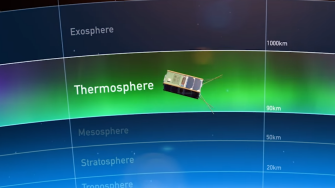Taking Australia’s satellite technology further
The breakthroughs giving us a clearer image of sea, sky and more.
The breakthroughs giving us a clearer image of sea, sky and more.

Professor Andrew Dempster, director of the Australian Centre for Space Engineering Research (ACSER) at UNSW, has been advancing satellite systems and navigation for over four decades. His recent work focuses on improving the precision of satellite data through the development of new space resources and global navigation satellite system (GNSS) reflectometry approaches.
Prof. Dempster and his team enhance GNSS receiver accuracy, benefiting agriculture, construction, and mining industries. Specialized receivers on satellite platforms also monitor sea scapes to better help with accuracy of weather prediction. “When you’re trying to work out climate impacts, most of the measurements come from space,” Prof. Dempster says. “The GPS signal reflects from the surface of the earth and we can then infer something about that reflection point – for example if it’s bouncing off the sea, you can tell how rough the sea is, the wind speed and the wind direction.” This data can then be used by weather prediction models to help forecast the future trajectory of cyclones.
The technology also monitors the ionosphere, a crucial region for understanding space-earth interactions. “This region is not fully understood and is hard to measure, yet it’s the interface between our planet and space. It’s where much of the ultraviolet and X-ray radiation from the sun collides with the earth and generates auroras and potential hazards that can affect power grids, communications, and GPS receivers,” says Prof. Dempster.
ACSER was established in 2010 – and under Prof. Dempster's leadership it has played a pivotal role in the Australian space sector's development. “The portfolio of what we do [in the centre] is quite fundamental to the way the Australian space sector has developed, and it’s changed the way the space industry works in Australia," he states.
Australia has a long-standing yet understated role in the space sector, notably broadcasting humanity’s first steps on the moon in 1969. UNSW's aerospace research dates back to a decade before this historic event, with major international collaborations, including those with NASA on shockwave analysis.
Space engineering however has come a long way since the moon-landing. For the last decade, Prof. Dempster and his team have also been focusing their attention on the development of space resources. “We’re currently looking at how you might go about getting water on the moon” he says. “We’re taking a unique approach because we’re bringing a mining engineering discipline to the space sector, which is quite different to the way everyone else does it.”
Prof. Dempster envisions a robust local space program in Australia’s future, reflecting on the progress made over the past decade. “10 years ago, no one thought Australia needed a space agency because it wasn’t necessarily something we had pursued or something we thought we could do here. But that has changed; we have become more independent, more free-thinking, and more ambitious”.
As Australia’s best engineering faculty turns 75, there are just as many reasons why we’ve earned that title. Discover new stories weekly, celebrating the successes that have enabled progress for all.